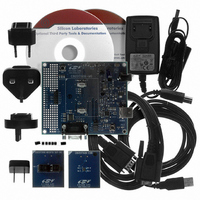C8051T606DK Silicon Laboratories Inc, C8051T606DK Datasheet - Page 4

C8051T606DK
Manufacturer Part Number
C8051T606DK
Description
KIT DEVELOPMENT FOR C8051T606
Manufacturer
Silicon Laboratories Inc
Type
MCUr
Datasheets
1.C8051T600EDB.pdf
(188 pages)
2.C8051T606TDB.pdf
(1 pages)
3.C8051T606DK.pdf
(16 pages)
4.C8051T606TDB.pdf
(14 pages)
Specifications of C8051T606DK
Contents
Board, Adapter, Cable, CD, Power Supply
Processor To Be Evaluated
C8051T606x
Interface Type
RS-232, USB
Maximum Operating Temperature
+ 85 C
Minimum Operating Temperature
- 40 C
Operating Supply Voltage
3.3 V
Lead Free Status / RoHS Status
Lead free / RoHS Compliant
For Use With/related Products
C8051T606
Lead Free Status / Rohs Status
Lead free / RoHS Compliant
Other names
336-1666
C8051T60x-DK
5.4.2. Building and Downloading the Program for Debugging
6. Example Source Code
Example source code and register definition files are provided in the “SiLabs\MCU\Examples\C8051T60x”
directory during IDE installation. These files may be used as a template for code development.
6.1. Register Definition Files
Register definition files C8051T600.inc, C8051T600_defs.h and compiler_defs.h define all SFR registers and bit-
addressable control/status bits. They are installed into the “SiLabs\MCU\Examples\C8051T60x” directory during
IDE installation. The register and bit names are identical to those used in the C8051T60x datasheet. The register
definition files are also installed in the default search path used by the Keil Software 8051 tools. Therefore, when
using the Keil 8051 tools included with the development kit (A51, C51), it is not necessary to copy a register
definition file to each project’s file directory.
6.2. Blinking LED Example
The example source files blink.asm and blinky.c show examples of several basic C8051T60x functions. These
include; disabling the watchdog timer (WDT), configuring the Port I/O crossbar, configuring a timer for an interrupt
routine, initializing the system clock, and configuring a GPIO port. When compiled/assembled and linked these
programs flash the green LED on the C8051T600 main board about ten times a second using the interrupt handler
with a timer.
4
1. Once all source files have been added to the target build, build the project by clicking on the Build/Make
2. Before connecting to the target device, several connection options may need to be set. Open the
3. Click the Connect button in the toolbar or select Debug
4. Download the project to the target by clicking the Download Code button in the toolbar.
5. Save the project when finished with the debug session to preserve the current target build configuration,
Project button in the toolbar or selecting Project
Note: After the project has been built the first time, the Build/Make Project command will only build the
files that have been changed since the previous build. To rebuild all files and project dependencies, click
on the Rebuild All button in the toolbar or select Project
Connection Options window by selecting Options
the “USB Debug Adapter” option. The USB Debug circuitry is integrated onto the C8051T60x main board.
Next, the correct “Debug Interface” must be selected. C8051T60x Family devices and the C8051F300 all use
Silicon Labs “C2” 2-wire debug interface. Once all the selections are made, click the OK button to close the
window.
Note: To enable automatic downloading if the program build is successful select Enable automatic con-
nect/download after build in the Project
build process, the IDE will not attempt the download.
editor settings and the location of all open debug views. To save the project, select Project
As... from the menu. Create a new name for the project and click on Save.
→
Target Build Configuration dialog. If errors occur during the
Rev. 0.1
→
→
Build/Make Project from the menu.
Connection Options... in the IDE menu. First, select
→
→
Connect from the menu to connect to the device.
Rebuild All from the menu.
→
Save Project










